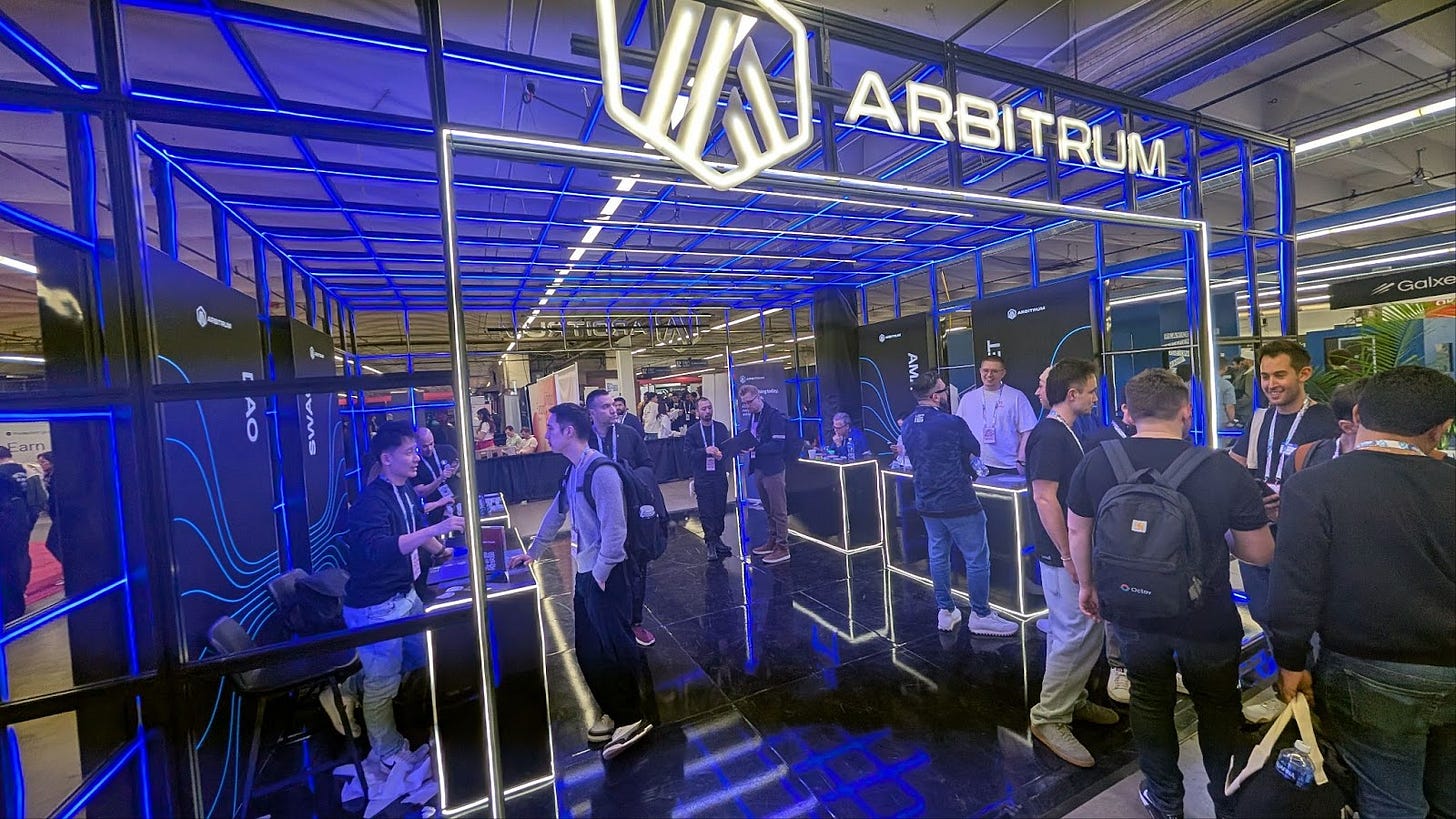ETHDenver 2025 Recap: Multi-Chain Expansion, AI, and Crypto’s Future
DeAI, Story, OAA, EigenDA, Agents, and stablecoins galore
Hey, what’s up y'all! I’m back from Denver after attending the main event portion of ETHDenver. The vibes were a bit different this year, more of a ‘we’re still here’ sorta feeling. A sense of brutal honesty about the state of the space permeated the event.
The euphoric highs of previous bull cycles are gone, but what remains are largely novel and interesting projects. Serious builders, long-term thinkers, and companies with budgets to throw large side events galore. This year was the true convergence of AI and web3. Last year was a taste of what was inevitable.
In this article, I’ll highlight key themes from this conference, my takeaways, and the aggregate of what I’ve heard online. While I wasn’t able to attend everything, I noticed a number of things that are noteworthy and deserve time to mull over. Data ownership, multichain interoperability, and AI integration were front and center.
Themes at ETHDenver
AI x Crypto: DeAI is the new default
Last year we got a taste of this, but AI has truly taken off in the web3 space now. Practically every project is now incorporating AI in some form or fashion. From AI governance to agentic interfaces and automation, this trend isn’t going away. The future of web3 is utilizing AI to reduce perceived abstraction and complexity on-chain.
The Open Agents Alliance (OAA) was announced, with participating teams consisting of NEAR, Eliza, Akash, Phala, Exhibits, and more. TL;DR: The Open Agent Alliance is a shared commitment to make the future of AI agents and assistants open, user-owned, and globally available to all while fairly rewarding its builders.
Tons of separate events were hosted for AI agents. I attended AI Agent Day, which was hosted by OG, Aethir, Avax, and more. A few panels focused on identifying sustainable value in AI agent ecosystems. Agents will be native to every blockchain.
As AI expands and engulfs the entire internet, we need a way to ensure agents are confidential end-to-end, verifiable, monetizable, interact via standard protocols, and transact in fiat and crypto. Fewer restrictions lead to greater adoption.
Much like NFTs and the metaverse were part of the last major cycle, AI is the darling of this cycle. Crypto latches onto emerging trends to explore new use cases and drive mass adoption.
There’s so much to say about this, so I’ll be doing an entire recap just on AiFi, DeFAI, and deAI at ETHDenver this week. There’s already too many platforms to follow or keep track with, and so much functionality is still in beta or barely worth using. The end state for crypto is just having a personalized agent that is capable of utilizing multi-chain tools and investing and following the space for you. Eventually, you’ll be asking AI what is happening in web3, and manual trading will be a thing of the past.
Our Inevitable Multi-Chain Reality
Unsurprisingly, a major focus has been on improving multi-chain UX. The foreseeable future entails multiple chains, interoperability, modularity, and asking how different chains can best serve specific purposes (like Story for IP).
Metamask had a strong presence at the conference, and announced upcoming Bitcoin and Solana support. The push will continue towards UI that is easier and easier to use.
Bitlayer introduced their BitVM Bridge, a more seamless way to connect Bitcoin with EVM chains.
Marc Rose and others hosted a Multichain Day at the Hilton downtown in Denver. This event focused on Bitcoin scaling and smart contracts, speed and scaling in general, a presentation by Agoric on facilitating a seamless multi-chain future, and a panel on multichain interoperability.
Conversations are few and far between for exclusive chain usage. Now, the community is focused on being able to seamlessly use chains and have less barriers for usage across the board. This is good, because I still do not think we have simplified this enough for mass adoption. I kept overhearing people saying that ‘this year is the year for mass adoption’. Ideally, yes, but the user experience just isn’t there yet. And, justifiable reasons that are easily understandable for participating in the crypto economy.
Institutional-Grade Products, Real Users, and Fewer Tourists
Speculative crowds have thinned. What is left are builders focused on solving problems for the current users (other crypto diehards, devs, institutional investors, and crypto OGs).
Institutional-grade Bitcoin staking is here, with projects like Babylon paving the way.
Fiat on/off ramp being directly integrated into DeFi wallets is now the norm. Moonpay, Transak, and Robinhood are working with Uniswap to allow for direct fiat off-ramping. This makes things easier for everyone.
Stablecoins once again take center stage. This is becoming common enough that entire conferences are now focused solely around stablecoins. For example, Paypal is expanding usage of their PYUSD stablecoin by launching a billing payment product that will allow retailers to use the stablecoin to pay suppliers.
Story was front and center. Yes, a blockchain for registering intellectual property on-chain makes sense. However, I do not understand why this cannot be a simple L2 on Ethereum. Why does this need to be a purpose built layer 1?
Conversations are maturing from concerns about price and ‘wen moon’ to scaling and sustainability. Stablecoins have a ton of use cases, and they will be one of the biggest factors and considerations when it comes to true mainstream adoption.
Hacker Houses and Side Events Were the Real ETHDenver
This was said time and time again at the conference: the real conference happens at side events and hacker houses. Meaningful, small, curated events are the name of the game now.
Bittensor hosted private dinners, where discussions were had about decentralizing compute marketplaces.
The Cosmos ecosystem had a strong presence. Cosmos SDK projects like Celestia and Berachain had plenty of their own events, with both having a strong marketing presence both at the event and most recently online (with Berachain’s launch and Celestia’s new campaign).
Female-led events have taken center stage. SheFi, HerDAO, and Berabaddies all had a presence at the conference, creating inclusive and organized sets of gatherings.
VCs are present, but they’re throwing capital towards projects that are solving real UX bottlenecks. We’re not just closing our eyes, throwing darts, and hoping it sticks.
Side events focused on deep tech, not just fluff and marketing. From EigenDA to new ZK solutions, conversations were more substantial, dense, and focused on results and the future.
Common Patterns and General Takeaways
ETHDenver is now more curated, and side events > main venue. The best insights happen in smaller spaces.
AI isn’t emerging, it is here. It is the default, and it is always in every conversation.
Multi-chain is a given. Let’s win together.
Regulation, enterprise, and real users are making projects grow up. Institutional-grade products are growing.
Tourists are gone. With ETHs price, the real builders are here and the people that care are showing up.
Final Thoughts
ETHDenver 2025 felt more intentional and subdued. Less about hype, more about meaningful progress. While complexity continues to be a challenge, the push for AI, multi-chain interoperability, and institutional-grade products suggests a maturing industry. The road ahead may not be simple, but at least it's clearer.
That’s it. I’ll be back in a couple days with an article on AiFi and the deAI conference in particular that happened in Denver during the conference. I’m back in the states for a couple days before heading to South Korea.
Be well,
- Chris









